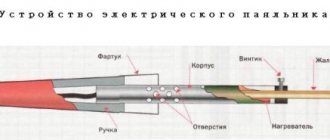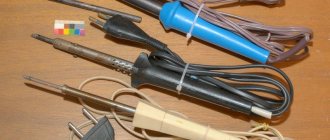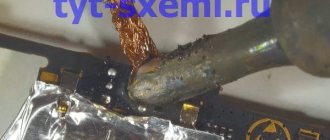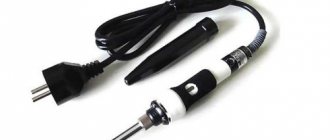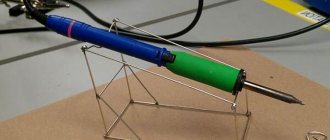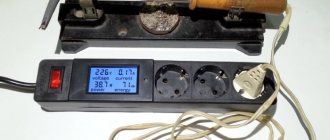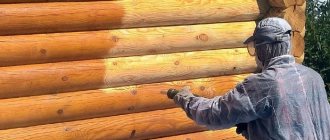Basic information about the tinning process
Tinning is divided into initial, carried out on a new or long-stored soldering iron, and working, performed immediately before soldering.
How to tin a soldering iron tip? First, the tip is mechanically cleaned of scale, oxide film, slag and other contaminants, then a thin layer of molten solder, most often tin-based, is applied to the prepared surface.
For mechanical cleaning the following are used:
- abrasive stone;
- sandpaper;
- another soldering iron.
Cleaning a soldering iron with a non-burn tip
For inexperienced soldering workers, craftsmen recommend starting with a file. As the solder strengthens his skills, he selects the most convenient stripping methods for himself.
Preparation and Maintenance
The more intense the work, the sooner the soldering iron tip burns out and becomes overgrown with scale scales.
During prolonged heating to high temperatures, the copper from which the tip is made partially transforms into molten tin, and partially abrades on the soldered surfaces and contacts. Physical and chemical erosion of the substance occurs. In addition, under the influence of heat, an oxidative reaction of copper with atmospheric oxygen occurs. On models that allow you to regulate the temperature, it is recommended to reduce it when there are breaks in soldering, or simply turn off the soldering iron during this time.
Sequence of operations to remove scale:
- Carefully remove the sting.
- Clean off the scale layer with fine-grained abrasive paper.
- Apply a graphite protective layer to the tip by rubbing it with a pencil lead. This will slow down the reappearance of the scale layer.
- Lightly tap the body of the electric heater and turn it to remove scale from the recess for the copper rod.
- Insert the tip back into the mount.
To ensure electrical safety, each time before starting work, you should inspect the insulation of the network cable for the absence of mechanical damage and melting.
From time to time it is also useful to measure the insulation resistance value. The measurement is taken between the plug contacts and the tip. The value must be greater than 10 mOhm.
Features of the sting
The sting is the main (and only) working part of the device. It is heated by an electric heater and heats the solder, rosin (or other flux) and the parts to be soldered. During operation, an invisible oxide film forms on it, reducing the wettability of the material. Visually it looks like this: tin or rosin does not spread evenly over the entire area, but collects in a drop and flows down.
The size and geometry of the working body are chosen so that they correspond to the operations performed. So, when soldering parts of large sizes and thickness, choose a powerful soldering iron with a thick tip. To install microcircuit legs, on the contrary, a particularly low-power device is required, with a thin tip and good grounding, so as not to damage sensitive components due to static charge or overheating.
Soldering microcircuits
A universal soldering iron is sharpened with a spatula. Thin parts are soldered with the narrow side, and more massive ones with the plane of the blade.
Various examples of soldering
The simplest soldering is soldering wires when performing electrical work. To do this, the wires are twisted together and soldered so that they do not heat up in the network and do not provide additional resistance. To do this job, it is better to use liquid flux, which can evenly cover the entire twisted surface of the wires and penetrate into the twist.
If you need to solder a small hole, you need to do the job a little differently. Under the hole it is necessary to place a refractory material such as asbestos or textolite, pre-lubricated with industrial fat, then cover the edges of the hole with liquid flux and place solder on the lining inside the hole. Then melt it with a soldering iron, spreading it over the entire area of the hole and grab its edges, heating them with a soldering iron. After the solder has cooled, you can remove the backing material.
In conclusion, we need to remind you of the need to follow basic safety rules, use a soldering iron stand and mat, and carry out work in a well-ventilated room. If you master this simple tool, you can independently repair various household devices.
Source: sanata-tech.ru
How to tin a soldering iron with a copper tip
Tinning a soldering iron is a simple job and usually does not cause any difficulties. If the surface of the rod is well prepared and cleaned, then both tin-lead and silver solders fit well on it.
Soldering iron with copper tip
It is necessary to clean the surface of the rod to the condition of a new part. First you need to work with coarse sandpaper, level the surface and give it the required shape. If it is technically possible, it is a good idea to polish the surface - this way it will oxidize more slowly.
There is another technique - binding. To do this, the tip should be pulled out of the heater and, like a blacksmith, forged with a hammer on an anvil (or a massive vice). A surface compacted in this way will also oxidize much more slowly.
After machining, it’s time to actually tin the tip. Experienced shareholders recommend various methods:
- Place a few pieces of solder in the rosin can. Heat the soldering iron and dip the stripped tip into it. Rosin melt will act as a flux additive and will prevent the metal from becoming coated with an oxide layer. Instead, it will be coated with a layer of tin. Next, you need to take a square of coarse natural cloth and wipe the freshly tinned tip. In this case, the tin will rub over the surface and stick to it perfectly. The disadvantage of this method is a lot of smoke and a strong smell.
- The next method of tinning the tip produces less smoke, but requires more labor. A piece of coarse natural cloth should be laid out on a smooth board, sprinkled with crushed rosin or a whole piece should be placed on it. Dip the stripped tip into rosin and rub the surface with a solder rod. This operation will have to be repeated several times, and then rub the working surface on rosin cloth.
A soldering iron with a copper tip must be tinned each time before soldering and always after storage without use.
Special means
As special agents, it is allowed to use active organic mixtures (fluxes), as well as pastes of a special composition. The use of fluxes makes it possible to increase the efficiency of wetting the tip material with solder and, accordingly, improve tinning performance.
Domestic manufacturers offer several types of flux, which are available for public sale in hermetically sealed plastic packaging. When working with a composition consisting of ethyl alcohol with added catalytic additives, the temperature in the processing area does not exceed 300 degrees. This indicator satisfies the requirements for choosing the correct tinning mode for most materials used for the manufacture of tips.
The procedure for using active paste additives differs only in the way they are applied to the surfaces being treated.
How to tin a soldering iron tip while working
If you carefully clean and tin the tip, then after half an hour of work, or even earlier, tin will no longer accumulate on it. The copper slowly began to burn, and slag residues accumulated on it. There is no point in pressing the soldering iron harder, stop for tinning. There are a number of techniques for tinning the tip.
Using a wooden block
A rough wooden block (spruce or pine, they contain natural resin, similar in composition to rosin). Pour a small amount of flux composition onto the block and put a small piece of solder. If you notice dross, you can strip and tin the tip again with little interruption.
In a metal sponge
This quick tin tip method will require some preparation. Place a household wire dish sponge in a metal cup. The lower part of the sponge should be coated with a thick flux, such as soldering lard. By slightly immersing the tip in the sponge, it can be cleaned of slag and scale. And if you pick up a drop of tin and immerse it deeper into the sponge, it will turn out to be tinned.
Tinning the tip with a metal sponge
This method can be used to clean and tin both a classic copper tip and modern ones made of nickel or ceramic.
In rosin
This traditional method of tinning requires a certain amount of dexterity and speed of movement. Copper oxidizes very quickly, and you may not have time to bring the tip from the point of mechanical cleaning to the container with flux. Therefore, they clean directly under flux, placing a file under the tip. You need to rub the tip over the file until the flux melts, after which you can tin it by holding a tin rod.
Tin the classic way
Another traditional method of tinning involves the use of refractory solder. The refractoriness of the solder allows it to evaporate more slowly from the surface of a tinned soldering iron and will remain on the copper longer. It will require:
- file with frequent notches;
- rough board made of coniferous wood;
- rosin;
- a piece of refractory solder.
The sequence of actions is as follows:
- put solder on the board;
- clean one side;
- dip deeply into rosin;
- quickly clean it on a board, running it over the solder;
- repeat for the second side.
Next, you should tin the round surface between the edges.
Soldering materials
Solder is used for soldering - a material used to join metal surfaces and having a lower melting point than the materials of the parts being joined.
Solder consists of different alloys, which may include tin, lead, copper, nickel and cadmium. It is made mainly in the form of rods and wire.
Soldering is necessary to create a connection, reduce the contact resistance of the electrical contact and protect the connection of parts from oxidation.
The solder must have the property of wetting the base. In this case, it diffuses into the base metal, and it dissolves in the solder, forming an intermediate layer that, after solidification, connects the parts as one whole.
For soldering irons, soft solders with a melting point from 1910C to 2800C are used. Their main components are tin and lead in different proportions.
It is necessary to remove oxides from the surface of the metals being joined for soldering. Fluxes are used for this. In addition, they promote better solder spreading and protect surfaces from the external environment.
Flux is used in solid, liquid and paste form. It may be located inside a solder tube.
The following are used as flux:
- rosin;
- acetylsalicylic acid;
- orthophosphoric acid;
- salt;
- glycerol;
- ammonia.
Common fluxes for soldering in solid, liquid and paste form
Fluxes must provide low leakage current and be non-corrosive.
How to tin a modern soldering iron tip
According to manufacturers' declarations, tips made of ceramic or nickel do not require tin-plating. In real life, they are also susceptible to the formation of soot and scale. It will not be possible to tin such a soldering iron in the usual way. You will need:
- cotton rags;
- jar of rosin;
- solder rod.
Soldering iron with ceramic tip
You should wipe the tip on a rag and immediately immerse it in rosin. Along the tip you need to immerse a solder rod in boiling rosin. It will melt and stick to work surfaces.
Metal sponge
There are often soldering irons on sale with the working part coated with special protective compounds made of stainless steel (this coating is called “non-burnable”). It has a thickness of several microns, so sharpening and tinning the tip is completely unacceptable due to the possibility of destruction of the coating due to strong friction.
In this case, the simplest method of dry tinning and cleaning the tip is used, using a steel sponge.
Its spring cells ensure good grinding of the tip and allow you to quickly tin its working surfaces. This method can be used when preparing soldering irons equipped with ceramic and nickel tips, as well as those with a very thin tip.
The special steel mesh can be replaced with a regular kitchen sponge. To clean the sponge itself, simply tap the mesh on the table, after which all the remaining solder will fall out at the bottom of it. The cost of this cleaning accessory does not exceed fifty rubles, so you can buy it immediately with a reserve.
With any of the proposed options, damage to the soldering iron due to strong pressure is practically excluded.
Tinning methods
There are several ways to clean work surfaces before tinning:
- Using abrasive materials. Needle file, file, whetstone, sandpaper.
- Using forging. It is recommended to remove the tip before processing it.
- Using another soldering iron. The tips rub against each other.
After stripping, you should immediately, without waiting for the oxide layer to recover, immerse the tip in a container with rosin. A rod of solder is also immersed there, melting it and allowing it to spread over the surface of the rod. This operation should be repeated several times to ensure that the working surfaces are completely covered with solder.
Next, rub the tip on a pine or spruce board to ensure even distribution of the solder.
Tinning with rosin
The tip must be carefully inspected. If there are areas not covered with solder, the operation should be repeated until a dewy continuous layer is obtained.
You won't be able to tin it once and for all. Tinning needs to be repeated periodically.
